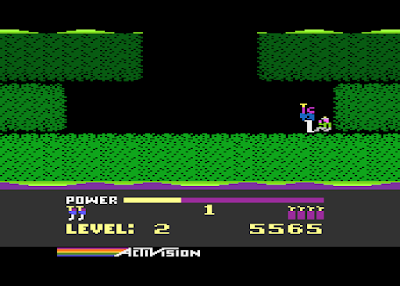Once more, I find myself not only faced with a game I've not heard of before, but also stuck in a video game mine. Well, I'm not stuck - I'm the hero that saves everyone else trapped in the mine, and a very mine-like looking mine it is. It really sells the idea that Roderick Hero, with his helicopter backpack, head mounted laser and bag of dynamite, is on a serious mission in a completely realistic environment.
So let's see how soon we and all who depend on our H.E.R.O. perish...
Frustrations
The 1001 Video Games book talks about how every single button on the Atari 2600 joystick is used with clear thought and planning. Left and right directions are obvious, as is the fire button for firing your weapon, leaving us with up and down to assign to our helicopter and dynamite. No prizes for guessing which direction was chosen for either.
The controls then are indeed simple, so why did I have such trouble with them? Moving left, right and up was a doddle, as you'd imagine, and so was shooting whatever was three feet in front of me, such is the range of your laser (clichéd stereotypical video game shotguns shoot further than this laser). But the dynamite - with its fuse shorter than a candle wick - had me scratching my head a bit.
I'm not ruling out that I'm stupid, but I couldn't drop a stick of dynamite and then fly away. I had to move left or right first, and which way made little difference because as soon as I took my second step the dynamite had gone off, so flying wasn't necessary.
After a bit of fumbling though, and a switch to the Atari 7800 port, I was well on my way through H.E.R.O.. Your objective is to navigate the mine, avoiding or, preferably - seeing as there are points available - shooting any threats you may encounter. Assuming you don't fall right into them. Which, from time to time, you will.
It's the old trial and error approach, but it doesn't feel too harsh. Often it's a 50-50 decision whether you go down a tunnel to the left or right, which both lead to the same cavern only one dumps you right into an enemy quicker than you can react. Respawns are quick at least, and any enemy you defeat - including by landing on them face first - disappear, leaving you to continue on your mission.
Fun Times
Little controls niggles aside, H.E.R.O. is an easy to grasp game. Your level goal is simple, just keep navigating down through the mine until you find someone to rescue. As soon as you get to them, that's the level finished with - no need to fumble about trying to get them back to the surface, which is great, thankfully, seeing as your helicopter has a draining power supply that you'll need to keep an eye on.
A set number of lives and a set amount of dynamite also keeps things simple, leaving it up to you to get through the obstacles in your way while racking up the high score as much as you can.
Final Word
Now I've been grumbling a fair bit in this review, but I do admit that H.E.R.O. is a neat little game idea, and is well executed. The physics don't quite feel how I'd imagine them to feel (or perhaps want them to feel), so it took a little getting used to before I really got going.
Whatever story there is flimsy at best, the graphics do their job, as does the sound. Nothing is terribly incredible on its own, and brought together they don't make for an incredible game, but it is a very playable one, and it doesn't require a whole lot of imagination in order to know what you're looking at, even if you have to suspend your disbelief a little.
Fun Facts
The SG-1000 port had Roderick fly with a jetpack rather than a helicopter, which somehow feels slightly more realistic. Maybe that's just me.
H.E.R.O., developed by Activision, first released in 1984.
Versions played: Atari 2600, 1984, via emulation.
Atari 7800, 1984, via emulation.



